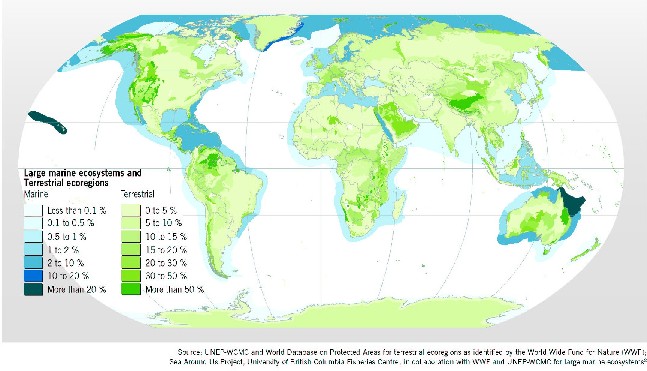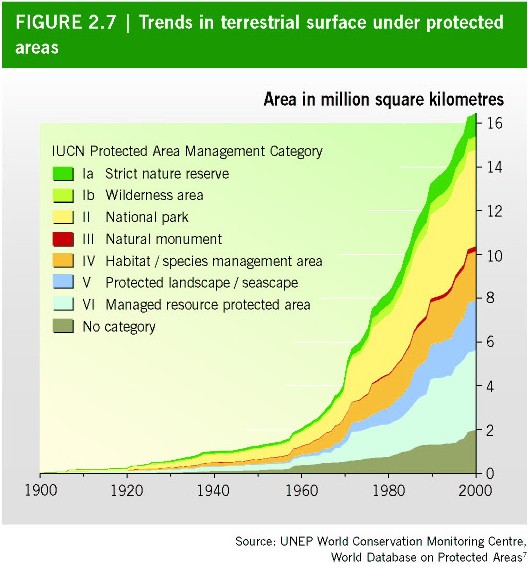(Recent map showing the extent of protected areas worldwide)
After recognizing this potential obstacle, a team of British researchers developed an objective method of "identifying priority areas for conservation," to quote the name of their recent paper in PLoS ONE. They first used pre-existing data on animal distributions in order to calculate the conservation importance of 5x5-km squares around the globe. In this case, the animals of interest were forest-dwelling birds, for which distribution data happen to be extremely detailed; additionally, forest habitats act as a sort of conservation umbrella, since these areas tend to have very high biodiversity. Impact scores indicate how many highly and moderately forest-dependent bird species inhabit each cell, and therefore offer a continuous measure of each cell's potential conservation impact--something of a novelty, since most previous measures tend to be binary or categorical.
The researchers overlaid their scores with several pre-existing datasets in order to further refine their estimates of which regions were in greatest need of conservation action. The first of these examined recent deforestation rates, and therefore pinpointed which areas were most likely susceptible to development; the next contained information on land that is already set aside for bird conservation purposes, thus pinpointing which areas are least regulated and, therefore, most vulnerable; the final dataset focused on areas with the greatest carbon stocks, allowing the researchers to determine how their results might fit in with the Reducing Emissions from Deforestation and Forest Degradation (REDD) project, an incentives program that attempts to reduce greenhouse gas emissions by avoiding deforestation.
In all, 6,077 bird species (or about 61% of the world's avian biodiversity) were considered in the analyses, and they cumulatively occupied a total of 2.2 million 5x5-km squares. Impact scores ranged from 0 to 4.01; although the average was quite low (0.0026), there was a skew such that only a handful high-scoring cells accounted for just over a quarter of the global sum. In other words, forest bird biodiversity is extremely high in a few key locations, including the Hawaiian Islands, São Tomé and Príncipe, Indonesia, the Philippines, New Guinea, the Atlantic Forests, the northern Andes, and South America. If you examine that list closely, you'll notice that areas with high impact scores tend to be islands, coastal areas, and mountains, with a few tropical lowlands thrown in for good measure; at the other end of the spectrum are low-ranking arctic and arid regions.
(Uses of terrestrial protected areas)
The mean deforestation rate across all cells with data was 1.3%. Deforestation was not necessarily greatest in areas with the highest impact scores, though there were some regions with both high scores and high rates of deforestation; these included the Cordillera La Costa mountain forests, the Halmahera rain forests, Mount Cameroon and Bioko, and Africa's Eastern Arc forests. Perhaps more troubling is the tiny fraction of all forested habitats covered by the current protected area network: Only 9% of the study cells contain protected forest, and 7 of 20 regions with the highest impact scores did not contain any protected forest at all. The good news is that the addition of a few select areas could not only meet the 17% protected area target proposed by the world's governments, but could also preserve nearly three-quarters of the globe's most biodiverse forests.
The researchers found a weak positive relationship between impact scores and carbon stocks, indicating that REDD activities alone will not provide absolute protection to these forests, though they certainly will help. A few "super-ecoregions" had high impact scores, deforestation rates, and carbon stocks, indicating that these areas are likely to be important targets of future conservation projects. These include the Seram rain forests of Indonesia, Borneo and Sumatra lowland rain forests and Sumatran peat swamp forests, Niger Delta swamp forests, Madeira-Tapajos moist forest, and the Isthmian-Atlantic moist forest.
(Recent estimates of the distribution of global biodiversity)
The analytical techniques employed here could easily be applied to other taxa, such as mammals and amphibians; additional groups, however, will need more complete distribution maps before their habitats can be given impact scores. Multispecies analyses will be useful for investigating the extent of overlap for "rarity, endemism, and risk." Despite the likely usefulness of their method, the authors admit that there are some important factors not considered here. For instance, they have not incorporated cost management data that could indicate which areas would give them the most conservation bang for the fewest bucks; further, they have not included data on non-deforestation pressures such as hunting or chemical pollution. However, these are all factors that could be added to later analyses as more information becomes available.
---
Buchanan, G.M., Donald, P.F., and Butchart, S.H.M. 2011. Identifying priority areas for conservation: a global assessment for forest-dependent birds. PLoS ONE 6(12):e29080.
Thanks to the following webpages for providing the images used in this post:
http://www.cbd.int/protected-old/needs.shtml
http://www.bgc-jena.mpg.de/bgc-theory/index.php/Research/2009-Biodiversity



No comments:
Post a Comment